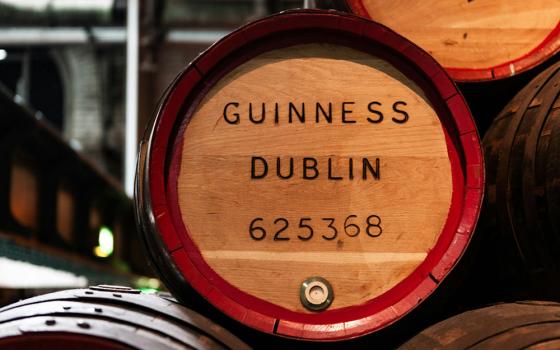
Architectural photograph of interior of Smithsonian National Museum of African American History and Culture, which opened Sept. 24, 2016. (Alan Karchmer/Smithsonian)
It was 1841, and a "war of the pews" was erupting in New Orleans.
French hatmaker Claude Tremé had divided his plantation and sold vast plots to free blacks. In 1834, Jeanne Marie Aliquot, a French woman, bought part of the property from the city. Aliquot, as Mary Bernard Deggs tells the story in the 2002 book No Cross, No Crown: Black Nuns in Nineteenth-century New Orleans, had slipped and fallen off the boat into the Mississippi River upon first arriving in New Orleans. When a black man dived in and saved her, the latter pledged herself to aiding the city's black people.
Aliquot sold the land in 1836 to the Ursuline sisters, who sold it four years later to the Carmelites. The following year, in 1841, Antoine Blanc, New Orleans' first archbishop, granted the city's free people of color permission to construct a church, which they did on property that the Ursuline sisters donated. The sisters asked that the church be named for one of their patron saints, and St. Augustine Church continues to operate today.
Back in 1842, the Sisters of the Holy Family community was founded, representing the nation's second oldest congregation of African-American women. Prior to the dedication of St. Augustine in October of the same year, white congregants learned that African-American parishioners were buying pews for their families. A pew war ensued. Free people of color ultimately won and "bought three pews to every one purchased by the whites," notes the church website. "In an unprecedented political and religious move, the colored members also bought all the side aisle pews. They then gave those pews to the slaves as their exclusive place of worship."
That mix forged the country's most-integrated congregation, "one large row of free people of color, one large row of whites with a smattering of ethnic folk, and two outer aisles of slaves," adds the website of the church, which celebrated its 175th anniversary last October.
Related: We, too, sing America: The Catholic church and the Museum of African American History and Culture (Feb. 6, 2017)
Two gifts from St. Augustine — a kneeling altar used at the church in the 1900s and a large votive holder, which held candles that St. Augustine parishioners lit — appear in a glass case at the new Smithsonian National Museum of African American History and Culture (NMAAHC) on Washington's National Mall.
The display, titled "Race and Sacred Space," also contains reproductions of a c. 1900 photograph of the Sisters of the Holy Family (from the Library of Congress collection) — an order which numbered 152 by 1930 — and of Paul Poincy's 1895 painting "St. Claude and Dumaine Streets, Faubourg, Tremé," from the Louisiana State Museum's collection. In the background of the painting, St. Augustine's steeple peeks out from between two telephone poles.
Just as it requires a careful eye to spot the Catholic church in the painting, Catholic references aren't exactly at the forefront of the museum's collection, but they appear in several different displays.
"Themes of religion and spirituality have been common threads in art since the beginning of its known human production," notes a museum wall panel. "African-American religious traditions have strong roots in Christianity, but include other pathways, including Islam, Judaism, and Buddhism."
Those strong roots in Christianity tend to be overwhelmingly Protestant, according to the Pew Forum on Religion and Public Life's "U.S. Religious Landscape Study." Both the 2014 and 2007 iterations of the study, which drew upon 35,000 interviews each, found similar percentages of African-American Catholics. In 2014, 3 percent of Catholics were African-American, compared to 2 percent seven years prior.
From the opposite side, 5 percent of African-Americans identified in 2014 as Catholic, notes Greg Smith, Pew Research Center's associate research director. That number is significantly eclipsed by those who identify as historically black Protestants (53 percent), evangelical Protestants (14 percent), and mainline Protestants (4 percent).
The overwhelming majority of religious references at the museum describe Protestant African-American stories — many of them about the African Methodist Episcopal Church, which separated from the Methodist Church, where seating was segregated, in the late 18th century.* Collection standouts include a bible belonging to Nat Turner, who led an 1831 slave rebellion, and a money box used by Richard Allen, who founded the A.M.E. Church.
But Catholicism remains an important thread in the museum's collection. A section on the Sisters of the Holy Family notes its founder, Henriette Delille (1812-62), a free woman of color, became the first African-American to be considered for Catholic sainthood.
From Global Sisters Report: History of rebuilding helps Sisters of the Holy Family after Hurricane Katrina (June 23, 2016)
Delille is one of four 19th century black Catholics introduced for canonization, said Cecilia Moore, an associate professor of religious studies at University of Dayton who studies the history of black conversions to Roman Catholicism in the 20th century.
More recently than the four — Delille, Mary Lange, Pierre Toussaint and Augustus Tolton — black Catholics have played central roles in the Civil Rights movement.
"Daniel Rudd, Homer Plessy, Thomas Wyatt Turner, A. P. Tureaud, and Victor and Constance Daniel and many others were voices of conscience calling the U.S. Catholic church to acknowledge ways it had capitulated to American racism and to use the social teaching and moral power of the faith to work for racial justice," Moore said.
Today, black Catholics number about 3 million in the United States, and that stability owes a lot to steady immigration of Catholics of African descent, according to Moore.
"Many of these people are coming from countries in Africa and the Caribbean that have strong Catholic traditions," she said. "Ghana, Nigeria and Cameroon are some examples. They are adding youth and vitality to the indigenous black Catholic community that, like the general Catholic community in the United States, is aging."
Shifting demographics have ushered in new worship styles, and black Catholics are trying to keep inner-city schools alive.
"Some of these efforts are more successful than others, but the fact that black Catholics are committed to keeping Catholic education alive in their communities attests to the value these schools have historically added to the lives of African-Americans in general," Moore said. The number of young black Catholics seeking priestly ordination remains very modest, she added, but a large number of young American Catholics grow up seeing Catholics of African descent on the altar and in the classroom.
That's one thing that parishioners at St. Augustine saw regularly, and the national museum's section on the church notes the power of that community when it rallied in the 1890s to fight Jim Crow laws and opposed a push in 1895 to establish a separate parish for black Catholics. The church joined with Creole citizens to protest a variety of laws, including racial segregation in schools and transportation. A display case includes a pamphlet of the Citizen's Committee (comité de citoyens), which protested the arrest of Homer Plessy in 1892 for sitting in a white section of a train. The arrest led to the Supreme Court hearing the 1896 Plessy v. Ferguson case.
The museum's collection also includes a studio portrait of a young girl in her first communion dress; a photograph of D.C. Mayor Marion Barry meeting Pope John Paul II in 1979, as Cardinal James Aloysius Hickey, Archbishop Eugene Antonio Marino (the nation's first Roman Catholic black archbishop), and Effi Barry, Washington's first lady, look on; and a picture of a 2003 children's nativity play at Washington's St. Augustine Roman Catholic Church. Another New Orleans Catholic church is depicted in a 2005 photograph of Fr. Victor Cohea blessing the sacrament at St. Francis de Sales Catholic Church (a pulpit he no longer holds).
The collection also includes a necklace associated with the Boa Morte (good death) sisterhood, a Brazilian Catholic group that descends from African slaves.
An art exhibition on the top floor of the museum also includes several religious works. Episcopal artist Allan Rohan Crite's 1947 painting "Stations of the Cross" depicts Jesus barefoot and clad in a flowing white robe shouldering the cross. His golden halo, which circumscribes a red cross emanating from the bloody crown of thorns, mirrors Mary's golden halo. She wears a white veil over blue and red robes and looks Jesus in the eye.
The work hangs alongside an almost apologetic wall label. "Although he is best known for creating images of black people in biblical scenes, in 'Stations of the Cross' [Crite] followed the Western tradition of depicting Jesus and Mary as white," the label states.
Crite, whom the Boston Globe called both the "dean of African-American artists in New England" and the Boston art scene's "granddaddy" when he died at age 97 in 2007, frequently worked for Episcopal and Catholic churches. His series "Madonnas of Transportation," according to the Globe, navigates the "thin line between ordinary and extraordinary, on how any mother and child on a subway are at once blandly familiar and sacred."
In a 1979-80 oral history interview, Crite told the Smithsonian that he went through a "personal Catholic revival of an Episcopalian" in the 1930s. He reflected further on his works that depict black figures in biblical scenes.
"The Episcopal Church in this country, of course, is predominantly non-Black; while the Anglican Communion, of which the Episcopal Church is a part, there is shifting to being non-white," he said at the time. "The same thing is true, I think, as far as the Roman Catholic Church is concerned."
The art exhibit at the museum also includes David Driskell's "Behold Thy Son" (1956), which was created in memory of Emmett Till, the 14-year-old boy murdered in Mississippi for allegedly flirting with a white woman. (Till's casket, which his mother left open during his funeral, is on display in a very moving exhibition at the NMAAHC.) Other religious works in the collection include a painting of Tobias by Kermit Coliver, Charles Wilber White's "Move On Up a Little Higher," and Henry Ossawa Tanner's "Disciples Healing the Sick" (1924), on loan from Clark Atlanta University. (Tanner's father was an A.M.E. bishop.)
Throughout the museum, one gets the sense not only of African-American Catholic history, but also of its present and future. That resonates with Moore, the professor in Dayton.
"Black Catholics enjoy celebrating their faith and their cultural heritage and history," she said. "It is not uncommon for a person to identify as a black Catholic and to see that there are unique things they add to the experience of Catholicism in the United States."
* Editor's note: This story has been updated to correct the history of the A.M.E. church.
[Menachem Wecker is co-author of the book Consider No Evil: Two Faith Traditions and the Problem of Academic Freedom in Religious Higher Education.]


